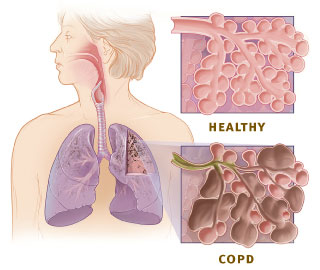The process of development of acne though known, it is clearly not known, why the process starts. The main pathological process is blockade of the skin openings of oil glands by keratin plugs near the hair follicles, the hormonal changes at the time of puberty. In fact, it is told that appearance of acne is indicative of puberty.
The main problem with acne is disfigurement of face from the comedo, and scars following its rapture and healing. This can cause much embarrassment particularly to the young ladies and may also cause psychological problems.
| Image via Wikipedia; Severe Acne Vulgaris |
Why the abnormal follicular keratinization occurs that is not known. But, abnormal keratinization, increases sebum production from the oil glands and secondary infection by Propionibacterium acnes (P. acnes) or infestation by domodex follicullorum; play major role in development of acne or acne vulgaris.
Increase sebum or oil production at that age is due to increased level of testosterone and oestrogen. Use of hash cosmetics or un-proved healing agents/remedies may aggravate the situation.
The primary skin lesion in acne is the microcomedo. Formation occurs when a keratin plug fills the duct of a pilosebaceous unit, which is comprised of a hair follicle and a sebaceous gland. Sebum is produced in the unit and some may be trapped beneath the keratin plug along with more keratinaceous material, causing enlargement of the follicle.
As the lesion enlarges it becomes clinically apparent and becomes a comedo. The comedo may remain functionally closed, appearing as a "whitehead." Or, the dilated follicular orifice may be open to the skin's surface, forming an open comedo or "blackhead."
On occasion the comedo may become inflamed and/or enlarge to the point of rupture of the follicular wall. This produces inflammatory papules, pustules, and nodules.
Acne is treated by variously from home remedies to doctors ranging from generalist to dermatologists.
Acne is managed by many different types of physicians. Dermatologists provide the majority of acne care, though half of the visits for acne in patients under 15 are with paediatrician. Internists and family physicians also treat acne, though the proportion of care provided by these practitioners is not known. Variations in practice between generalists and specialists have been documented. However, there have been no studies exploring differences in outcomes by provider type.
There are several different medications available for the treatment of acne. Broadly, these can be divided into topical therapies and systemic (oral) therapies.
In general, mild cases are treated with topical medications, with more severe cases being treated with systemic therapy or a combination of topical and systemic treatments. However, acne treatment tends to be highly individualized due to the spectrum of lesions.
Topical therapies include;
- Cleansers,
- Keratolytics, and
- Topical antibiotics and
- Topical retinoids.
The main action of keratolytics is to increase follicular desquamation and decrease follicular plugging. Common keratolytics include salicylic acid, sulphur, and resorcinol.
Topical treatments for teen aged acne include benzoyl peroxide, sulphur, resorcinol, or salicylic acid are there. The US Food and Drug Administration ( FDA) has found these effective for treating acne.
Antibiotics suppress P. acnes. Common topical antibiotics are erythromycin and clindamycin. Benzoyl peroxide has both antibiotic and keratolytic properties.
Topical retinoids such as tretinoin and adapalene reduce hyperkeratosis and follicular plugging. Many of the topical agents are available in cream, liquid, and gel formulations.
Systemic therapies include;
- Oral antibiotics,
- Oral retinoids, and
- Hormonal treatments.
Oral antibiotics used to treat acne include tetracyclines, macrolides, and sulfa-containing agents. Some of these agents may have anti-inflammatory activity as well as antibiotic activity.
Isotretinoin is currently the only oral retinoid routinely used in the treatment of acne. While its exact mechanism of action is unknown, it decreases both sebaceous gland secretion and keratinization.
Oestrogen and anti-androgens are systemic medications that may be used in specific cases.
There are dozens of other treatments for acne that have been used or are currently in use. These include Grenz rays (a type of x-rays irradiation), anti-fungal treatments, acne surgery, topical and oral steroids, and alternative therapies such as tea tree oil.
Chemical peels and microdermabrasion are used to lighten post-acne scarring. Post-acne scars can be cleared by clean-ups with salicylic or glycolic acid at a clinic. Gentle exfoliation with these acids helps in taking out blackheads and whiteheads.
Garlic juice or a mud pack are used to decrease the oily skin.One can apply a little garlic juice on face, for about an hour at least once a week. Although garlic juice kills off acne-causing bacteria, it should not be kept too long as it can aggravate sensitive skin.
Laser treatment and chemical peels are available as alternative treatment. Yttrium scandium gallium garnet ablative fractional resurfacing (2,790-nm) appears to be effective and well tolerated for the treatment of atrophic acne scars.
To avoid acne, one should wash skin twice a day. Make sure to use a mild face wash that suits one’s skin type. Washing face too frequently especially with harsh cosmetics can aggravate acne. Avoiding processed foods like white bread and noodles are good as those often trigger outbreaks.
Use a face pack made of Fuller's earth (non-plastic clay or clay-like earthy material) at least once or twice a week. This will help extract excess sebum and is therefore one of the best natural methods to treat acne.
...
Click here to Subscribe news feed from "Clinicianonnet; so that you do not miss out anything that can be valuable to you !!
...






